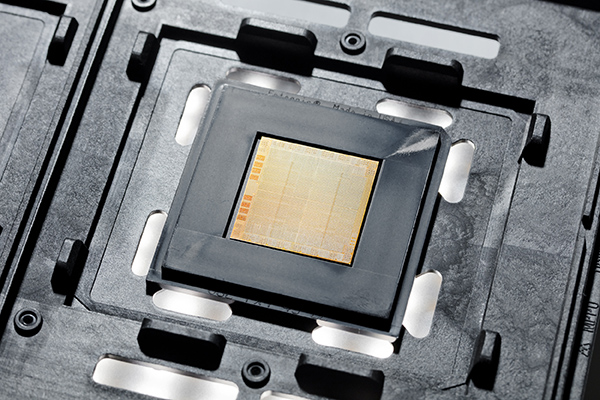IBM Systems
Q&A: Stephen Leonard on the Business Value of IBM POWER10
IBM Cognitive Systems General Manager Stephen Leonard spoke with us about how IBM POWER10, the tenth generation of the IBM POWER processor family, is expected to deliver business value to large and small enterprises in the age of AI and Hybrid Cloud when IBM POWER10-based servers reach customers in the second half of 2021.

A collection of IBM POWER10 7nm processors on a silicon wafer. Each IBM POWER10 chip can deliver up to
3x the capacity and energy efficiency of the previous generation and up to 20x faster INT8 AI inferencing.
What are the first things customers need to know about IBM Power Systems and the IBM POWER10?
IBM Power Systems have been indispensable to both enterprise clients and small- and mid-sized businesses (SMBs), and our new generation IBM POWER10 processor is designed to be even more differentiated. This 7 nanometer chip is about the size of a postage stamp and houses 18 billion transistors. If you’re an enterprise client in any industry from retail, telecom, financial services to healthcare, the POWER10’s goal is to be a state-of-the-art, enterprise-class enabler of your business processes that doesn’t have to live in a data center.
We designed the IBM POWER10 processor so enterprise clients can run IBM POWER10-equipped servers on-site for high-speed processing that’s reliable and secure. For example, you’ll find today’s IBM Power Systems servers in pharmacies that need immediate and secure tracking of patient prescriptions while complying with government privacy regulations. Telecom clients use IBM Power Systems for enterprise-class AI and hybrid cloud capabilities across a network of facilities. And automotive parts suppliers use them in the increasingly automated world of advanced manufacturing.
Among SMBs, we’re seeing IBM Power Systems deployed to handle business-critical workloads in environments where bulletproof reliability and security are required, but they don’t have capacity for a larger system such as a mainframe, to run their critical applications. A mid-sized customer with task-specific computing requirements may not be able to invest in a raised-floor, environmentally controlled data center, but may still demand an enterprise-grade server for sensitive and sophisticated operations.
That’s why I liken IBM Power Systems to a boutique hotel when it comes to client service. IBM Power Systems provide an enterprise-class experience with as much customization as a client needs. And it does so anywhere it’s needed, reliably, securely and with new standards for compactness, speed and energy efficiency.

IBM’s new POWER10 chip is built for the hybrid cloud era and includes breakthrough new features
including memory inception to improve cloud capacity, with quadruple the number of encryption engines
for today's toughest standards—and anticipated future standards like quantum-safe cryptography.
Describe the role of IBM Power Systems role digital transformation, AI and Hybrid Cloud.
Clients often want to stick with the systems they have—especially if they’ve enjoyed the kind of performance and flexibility they’ve had with IBM Power Systems over the years. At the same time, any debate about AI and hybrid cloud is over. The question is no longer “if,” but “when?” and “how fast?” In addition, the global pandemic has made it abundantly clear that companies who were thinking about AI and hybrid cloud need to make their moves now. IBM Power Systems can serve as the on-ramps to digital transformation by bringing AI and hybrid cloud capabilities to new clients, and to our tens of thousands of established clients, without the disruption and expense of “rip and replace.”
Take AI, for example. It has to be trained. And that training requires tremendous computing power. An enterprise client may not wish to dedicate mainframe capacity to such training, while an SMB client might not have access to a mainframe. But some members of our IBM Power Systems server family can run AI training modules at speeds up to 4 times faster than a larger enterprise system. Power also can run AI inside applications. And between IBM’s vast software library and ISV ecosystem, there are solutions available to help any size enterprise develop its own AI.
Hybrid cloud is being driven by all the things that drove public cloud in the beginning—flexibility, collaboration for innovation, speed to market. This all gives the client the ability to be nimble, pivot to new market opportunities or react to competitive threats. These attributes now have clients saying, “I need that throughout my entire enterprise—it can’t just sit outside my enterprise.” As the only player that leads in both cloud and on-premises systems—and with our commitment to open source hybrid cloud architecture based on Red Hat OpenShift—IBM is optimally positioned to migrate clients to hybrid cloud, and IBM POWER10 is designed to serve as the foundation of that cloud.
What makes IBM POWER10 stand apart from the rest of the industry?
Clients want to know that they have the highest level of cybersecurity—which we’ve designed IBM POWER10 to deliver on. With IBM POWER10 all of the memory is encrypted all of the time—without software cryptography—so there is no performance degradation. Combine that with the fact that IBM POWER10 is designed with a memory architecture for bandwidth and resiliency. With IBM POWER10-based systems you will have a secure memory environment which is incredibly important in this hybrid cloud world when you’re moving applications around.
We’re also unveiling a new technology built in IBM POWER10 called Memory Inception. This capability is designed to allow clients to create memory pools across multiple IBM POWER10-based systems—so they can scale to multiple petabytes of memory. The applications can run on a single system but they can access the memory wherever it is just like it’s on the system it’s running on. Given the wide range of applications that are now memory intensive—we’re talking CRM, ERP supply chain applications—this is expected to be a gamechanger for those environments.
IBM POWER10 is built for these large enterprises running very large applications that have high levels of resiliency security and scalability requirements.